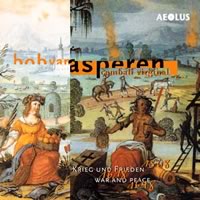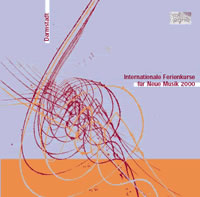Four Centuries Apart 1.
|
Walt Mundkowsky [February 2003.]
War and Peace 1568-1618-1648. By Anon., Antonio de CABEZÓN, Francisco Correa de ARRAUXO, Jan Pieterszoon SWEELINCK, Cornelis Thymanszoon PADBRUÉ, Gustav & Andreas DÜBEN, Peter PHILIPS, Orlando GIBBONS, William BYRD, Claude LEJEUNE, Louis COUPERIN and Johann Jacob FROBERGER. Bob van Asperen (harpsichords, virginal). Aeolus AE-10014 (http://www.aeolus-music.com/). Bob van Asperen stood out in Gustav Leonhardt’s first wave of gifted pupils (Alan Curtis and Ton Koopman among them). He aided Leonhardt on the mirror fugues in a 1969 The Art of Fugue (DHM GD77013), but arrived as soloist with a Frescobaldi recital (Teldec 2292-43544-2) that’s still potent 25 years later. Rousing C.P.E. Bach (8573-85561-2) and John Bull (4509-95532-2) discs followed, and 1989-91 brought a string of splendid items on EMI (including my favorite Goldberg Variations and Bach Toccatas). After that I lost contact. (A 12-CD Soler run [on Astrée] fell under the heading “too much information.”) His Aeolus debut (the first of five thus far) puts the stirring and the plaintive into a cause-and-effect weave. The wide-ranging program spans the wars (Netherlands-Spain and German states-France-Sweden) ended by the Westphalian Peace of 1648. Six tour stops proceed as follows: Spain Things start literally with a bang — an unattributed battle piece. Since van Asperen enjoys a rep as a bravura toccata player, he’s comfortable. Short motifs (fanfares) hit in different registers and clotted lines convey the tumult, racing into a furious climax as van Asperen leads the cavalry. Tientos by Cabezón (1510-1566) and Correa de Arrauxo (c.1576-1654) display the Renaissance / early Baroque divide. The earlier one has the imprint of Musica Nova, a 1540 book of Ricercari from Willaert and others (Stradivarius STR 33355). An unhurried opening climbs, with mounting complexity, to a grand chorale. More elaborate, the Correa de Arrauxo takes a surefire path, declaiming the melody (with interruptions) in the treble over a bedrock of busywork. (And van Asperen’s skill at keeping them separate recalls Horowitz in his prime.) Netherlands Wilhelmus is a sturdy, lilting song (now the Dutch national anthem). Sweelinck (organist at Amsterdam’s Oude Kerk from 1580) can’t be avoided here, and van Asperen imparts a character seldom heard. He plays two variation sets created in response to specific events. Engelsche Fortuyn and Pavana Lachrimae move similarly, stating the basic tune before embarking on elaborate flights of division-like activity. (The latter is based on Dowland’s famous number.) Again, van Asperen’s ordering of discrete layers impresses. A long step down from Sweelinck comes Padbrué (1592-1670), whose Pavana und Gaillarde remain rudimentary and sectional. Sweden Düben father and son contribute a slight Bourré, and van Asperen has a surprise on hand: Peter Philips’ Pavana und Galliarda Dolorosa, penned during a spell in prison. (Andreas Düben copied it down while studying with Sweelinck.) Its anguish is located in wayward notes, unresolved harmonies and distracted progress (alternating blocks of ornamentation and slow buildup). As expected, van Asperen sails into the energetic Galliarda with flags flying. England Orlando Gibbons’ elusive keyboard oeuvre often misfires on disc, so much so that Glenn Gould, with the wrong instrument and tuning system, comes nearer the matter than many “historically informed” folk (Sony SMK 52 589). The great Pavana Lord Salisbury fares well — more expressive and flowing than under Gould (van Asperen also makes more out of the falling phrase at the end). Like its Spanish counterpart, Byrd’s The Battle is superb fun. Precise yet ripping, van Asperen makes the marches distinct (a droning bass on “The March of the Horsemen” calls up bagpipes) and saves his heavy artillery for the rout. The Galliard for the Victory is joyous and sweeping. France The vocal origins of Claude Lejeune’s 5ème verset du psaume 110 show in the seamless melodic curves (van Asperen has adapted a lute transcription). As with Sweelinck, Louis Couperin (1626-1661), uncle of François “Le Grand,” would be hard to ignore. No doubt this Suite in E was chosen for its slow movement, “Allemande de la Paix.” The execution convinces — irregular stresses, much use of tied notes, oddly constructed harmonies. Very free rendering also marks the Prélude, and rightly, for the composer provided no bar lines or time signature. Germany A brief Ballet van Asperen located in a library couples canonic ingenuity with a symbolic message. Froberger (1616-1667) is another easy inclusion, and van Asperen draws on his Frescobaldi work to provide a stiffer spine than is customary. (Froberger’s lute influences can be overdone.) Toccata III is dedicated to the emperor Ferdinand, who sent Froberger to learn from the Italian master. This is van Asperen at his best — a seemingly improvised beginning, mercurial fades and starts, passagework near the speed of thought. It baffles to find the same mechanics bent, in Froberger’s Lamentation for the dead emperor, to form a wrenching memorial. The halting or onrushing tread and suspended chords are redolent of grief. Three modern reproductions of old instruments see service: a robust-sounding Ruckers, a more incisive Italian model and a piquant virginal. None astounds, but the varied palettes ensure interest. The recording favors immediacy over ambience, and van Asperen’s notes lend the music a wider context. Honored in Europe, War and Peace is a stimulating disc. Buying info: I snagged War and Peace via MDT Mail Order (http://secure.mdt.co.uk/), a reliable U.K. firm. They can also supply the C.P.E. Bach and Frescobaldi CDs, and I’d be remiss without citing van Asperen’s 1989-90 Well-Tempered Clavier. Its four discs are a mere £9.79 (less than most full-priced single CDs), as Virgin 7243 5 61711-2. The Art of Fugue, Bull and Willaert entries survive in the German catalog, notably on www.amazon.de.
40. Internationale Ferienkurse für Neue Musik Darmstadt 2000. Johannes KALITZKE: Cruxification II (1999). Helmut OEHRING: Philipp (1998-99). Misato MOCHIZUKI: Pas à pas (2000). Isabel MUNDRY: Traces des moments (2000). Alwynne PRITCHARD: Invisible Cities (1999). Jennifer WALSHE: as mo cheann (2000). Various performers. col legno WWE 1CD 20056 (http://www.col-legno.de/). A major part of the col legno mission is releasing contemporary music from festival gigs. (Philip Larkin’s dig at Norman Granz, that “he brought the technique of pattern-bombing to jazz recording,” is perhaps relevant.) For tourists like me, one CD is more feasible than the label’s big sets, and the six composers embody a range of creative solutions. Relying on the sequence at Darmstadt (July 14-27, 2000) has given the disc a weird arc — the main course comes first. But listeners will devise their own menus. Here’s mine: Valuable Johannes Kalitzke leads Klangforum Wien, a fine new-music outfit. He also conducts big orchestras and composes. Cruxification II projects a B.A. Zimmermann air, breaking the orchestra into glittering chamber groups and “painting the surface of a traditional object.” After rustling and scraping, bits of the medieval chorale “Christ ist erstanden” (risen) are scattered through the orchestra. The importance of chimes and woodblocks will continue. Viewing the crucifixion as a mad carnival, the next two movements boast cackling horns and dancing string figures. A quiet, sustained finale erases them, with insistent flute leads and ghostly strings. This well-crafted score sticks in the mind. Wergo’s striking CD of four Isabel Mundry works (WER 6542-2) left me wanting more, and Traces des moments (for accordion, clarinet and string trio) doesn’t disappoint. Done following a trip to the garden at Kyoto’s Nanzenji temple, Traces begins with a coup — a pluck-and-sul ponticello that imitate the koto. The quintet’s layout is deceptive; the string players carry the complex argument (skipping or slashing bow strokes, pizzicati, slides or whines) as the others lay down shifting pedal tones. Mundry can flip-flop these rôles, too, building overlapping cello, viola and violin drones or rising unison effects. This bubbling 13-minute game is kept aloft by Teodoro Anzellotti (New Music’s accordionist) and four mainstays from ensemble recherche. A vivid recording highlights furious page-turning at 4:40 and 9:38. Iffy Beyond the play of sonorities, little is ventured in Misato Mochizuki’s Pas à pas. After a languid intro, she essays accordion crescendi that spread like spilled syrup and glowering bassoon stances. The duo exchange telegraphic beeps, and faster rhythms lead to dancing runs in double, then triple time. Anzellotti slips in glancing café hints, and Pascal Gallois has a silky upper register — his bassoon can sometimes pass for an alto sax. An agreeable but slight 7:41, odd for Darmstadt. In description Alwynne Pritchard’s Invisible Cities excites — a maze plan with open-form parameters. Each word and punctuation mark in the final sentence of Italo Calvino’s book has a page in the score — 29 pages total. Identical words or marks can exchange positions, so events can occur variously, and instructions present other options (“Or you may play a single note and hold it for as long as you like”). Hearing it, though, is a letdown. Much of the material seems ordinary, and it hasn’t remotely the span of Boulez’s unfinished Third Sonata (1957), the obvious exemplar. Nicolas Hodges is saddled with a dull piano, and he completes a 7:01 lap. (In his studio taping on Metier MSV CD92040, dedicatee Ian Pace takes 13:30.) Also, audience noise swallows some of Hodges’ delicate fingerwork. Not for me Darmstadt has a long history of support for radical experimental efforts. Not my aesthetic zip code by any means, but I’ll describe the two examples without prejudice. Philipp (by Helmut Oehring) is a showpiece for trombonist Uwe Dierksen and his lips of steel — 5:32 of mostly rapid slurring lines. Blats and squeals are also required and a stately tune arises at the climax, possibly comic. Jennifer Walshe is her own soprano on as mo cheann (out of my head). Drawn-out tones (“from the space above the head down to the bridge of the nose”) predominate, but an unintelligible whispered text and percussive stones also assist. David Ryther’s violin (squeaking, skittering, sawing) offers end-to-end commentary. A batting average of .333 is acceptable for CDs of this sort, and the recording (from three different venues) is decent. The well-designed booklet contains many photos and relevant background. Buying info: Acquired from the efficient ordering facility on col legno’s Website. “Christ ist erstanden” is featured, unadorned and embroidered, on Hymn Vignettes & Variations, one of Bradley Lehman’s five superior clavichord recitals on www.mp3.com.
Arrauxo, Byrd, Couperin, de Cabezon, Duben, Froberger, Gibbons, Kalitzke, Lejeune, Mochizuki, Mundry, Oehring, Padbrue, Philips, Pritchard, Sweelinck, Walshe
[More Four Centuries Apart, Walt Mundkowsky]
[More
Arrauxo, Byrd, Couperin, de Cabezon, Duben, Froberger, Gibbons, Kalitzke, Lejeune, Mochizuki, Mundry, Oehring, Padbrue, Philips, Pritchard, Sweelinck, Walshe]
[Previous Article:
An Eclectic Stringed Ramble]
[Next Article:
New Goldbergs and Old Gouldbergs]
|

